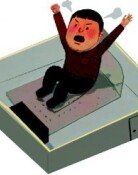National Museum of Korea invites audience to a new exhibition
National Museum of Korea invites audience to a new exhibition
Posted October. 20, 2016 07:23,
Updated October. 20, 2016 07:30

“Along the River During the Qingming Festival” is an artwork by the 16th-century Chinese artist Qiu Ying. In order for audience to have a closer look at the painting, consists of two scrolls, each 9.8-meter-long, they have to crane their necks and stretch their backs no matter how much pain it will cause them. The painting is not only wide but also filled with so much entertainment to enjoy as one follows thorough every detail of the painting. Qiu Ying created an ideal city based on Suzhou, a city that had been known for its prosperity, by incorporating his imagination. This vibrant urban life where commerce plays a central role inspired realist scholars in the Joseon Dynasty who emphasized pragmatism. Famous realist and writer Park Ji-won was so inspired by Qiu Ying’s painting and could even find the genuine piece among seven fake copies.
The National Museum of Korea’s new exhibition “The City in Art, Art in the City,” opened on October 5, displays Chinese treasures “Along the River During the Qingming Festival” by Qiu Ying and “Prosperous Suzhou” by Xu Yang. By examining 373 pieces of artworks of Korea, China and Japan, the exhibition is a rare opportunity to see how urban life is depicted in paintings of the three Asian countries from the 18th century late Joseon Dynasty to the 1930s. Xu Yang’s “Prosperous Suzhou” depicts urban life of Suzhou through 4,800 people and 2,100 buildings. Unlike “Along the River During the Qingming Festival,” for which Qiu Ying added his imagination to invent an ideal world, “Prosperous Suzhou” shows actual scenery of the city. This is a unique opportunity to appreciate both paintings in one place. Do not miss this rare chance to see original paintings as they will be replaced with a replica after Sunday.
Collection of paintings of famous painters in the late Joseon Dynasty, including Kim Hong-do and Shin Yoon-bok, will also provide a chance to explore urban life in the Joseon Dynasty.
Ticket price is 5 dollars for adults and 4 dollars for children. The exhibition runs through November 23.
김상운 기자sukim@donga.com







